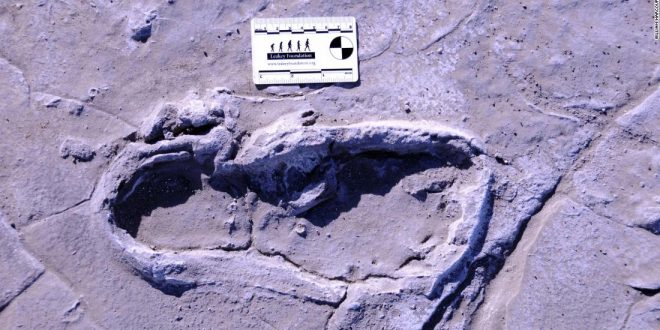Fossilized human footprints may reveal ancient traditions – Tek Portal

This is one of the 408 human footprints preserved at the Engare Sero site in Tanzania. The fossilized footprints reveal a group of 17 people that traveled together, likely including 14 women, two men and one juvenile male.
Blade-like stone tools and beads found in Bulgaria’s Bacho Kiro cave provide the earliest evidence for modern humans in Europe 47,000 years ago.
This artist’s illustration shows what an early, small ichthyosaur that lived 248 million years ago may have looked like. It resembled a cross between a tadpole and a seal, grew to be one foot long and had pebble-like teeth that it likely used to eat invertebrates like snails and bivalves.
This is an artist’s illustration of Adalatherium hui, an early mammal that lived on Madagascar 66 million years ago.
This is an artist’s illustration showing a cross-section of Earth’s forming crust approximately 3 to 4 billion years ago.
Illuminated medieval manuscripts are full of intricate decorations, illustrations and colors, including “endangered colors” that can no longer be recreated today.
These monkeys can be found in ancient Grecian frescoes. And the details are so accurate that researchers were able to identify them as vervet monkeys and baboons.
Archeologists have found the oldest string of yarn at a prehistoric site in southern France. This photograph, taken by digital microscopy, shows that of the cord fragment, which is approximately 6.2 mm long and 0.5 mm wide.
This illustration shows Elessaurus gondwanoccidens, a long-legged reptile that lived in South America during the Early Triassic Period. It’s a cousin to other mysterious early reptiles that arose after the Permian mass extinction event 250 million years ago.
The skeletal remains of Homo antecessor are on display in this image. A recent study suggests antecessor is a sister lineage to Homo erectus, a common ancestor of modern humans, Neanderthals and Denisovans.
A nearly two-million-year-old Homo erectus skullcap was found in South Africa. This is the first fossil of erectus to be found in southern Africa, which places it in the area at the same time as other ancient human ancestors.
This painting shows what Antarctica may have looked like 90 million years ago. It had a temperate swampy rainforest.
This artist’s illustration of Dineobellator notohesperus shows them in an open landscape, across what is now New Mexico, along with Ojoceratops and Alamosaurus in the background.
Ikaria wariootia was a worm-like creature that lived 555 million years ago. It represents the oldest ancestor on the family tree for most animals.
This is the 3.67-million-year-old ‘Little Foot’ skull. The view from the bottom (right) shows the original position of the first cervical vertebra, which tells us about her head movements and blood flow to the brain.
This is an artist’s illustration of the world’s oldest modern bird, Asteriornis maastrichtensis, in its original environment. Parts of Belgium were covered by a shallow sea, and conditions were similar to modern tropical beaches like The Bahamas 66.7 million years ago.
This donkey skull was recovered in a Tang Dynasty noblewoman’s tomb. The researchers determined that she played donkey polo and was buried with her donkeys so that she may continue her favorite sport in the afterlife.
Hundreds of mammoth bones found at a site in Russia were once used by hunter-gatherers to build a massive structure 25,000 years ago.
A fossil of an ancient rudist clam called Torreites sanchezi revealed that Earth’s days lasted 23.5 hours 70 million years ago.
This is an artist’s impression of dinosaurs on prehistoric mudflat in Scotland, based on varied dinosaur footprints recovered on the Isle of Skye.
A new study suggests that ostrich eggshell beads have been used to cement relationships in Africa for more than 30,000 years.
This rock lined the seafloor roughly 3.2 billion years ago, providing evidence that Earth may have been a ‘waterworld’ in its ancient past.
These stone tools were found at the Dhaba site in India, showing that Homo sapiens survived a massive volcanic eruption 74,000 years ago.
The remains of 48 people who were buried in a 14th century Black Death mass grave were found in England’s Lincolnshire countryside.
The articulated remains of a Neanderthal have been found in Shanidar Cave, representing the first discovery of its kind in 20 years.
A rare disease that still affects humans today has been found in the fossilized vertabra of a duck-billed dinosaur that roamed the Earth at least 66 million years ago.
Venezuelan Palaeontologist Rodolfo Sánchez is shown next to a male carapace of the giant turtle Stupendemys geographicus, for scale.
This artist’s illustration shows the newly discovered Tyrannosaurus rex relative, Thanatotheristes degrootorum.
The newly discovered species Allosaurus jimmadseni represents the earliest Allosaurus known. It was a fearsome predator that lived during the Late Jurassic Period millions of years before Tyrannosaurus rex.
Remains…







